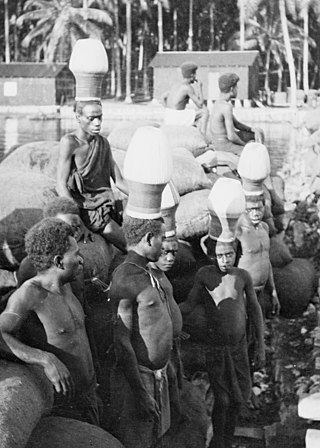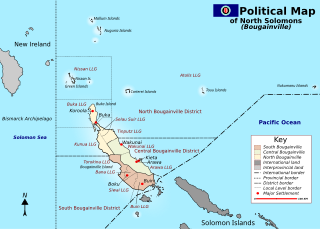
Bougainville, officially the Autonomous Region of Bougainville, is an autonomous region in Papua New Guinea. The largest island is Bougainville Island, while the region also includes Buka Island and a number of outlying islands and atolls. The current capital is Buka, situated on Buka Island.
The Bougainville Revolutionary Army (BRA) was a secessionist group formed in 1988 by Bougainvilleans seeking independence from Papua New Guinea (PNG). The leader of the BRA was Francis Ona who led the BRA against the Papua New Guinea Defence Force during the violent 10 year conflict. Not all BRA members agreed to the Peace Treaty and boycotted it, and have held out in an official no-go zone, protected by members of the Meekamui Defence Force, currently commanded by Moses Pepino.

For administrative purposes, Papua New Guinea is divided into administrative divisions called provinces. There are 22 provincial-level divisions, which include 20 provinces, the Autonomous Region of Bougainville, and the National Capital District of Port Moresby.

Bougainville, an autonomous region of Papua New Guinea (PNG), has been inhabited by humans for at least 29,000 years, according to artefacts found in Kilu Cave on Buka Island. The region is named after Bougainville Island, the largest island of the Solomon Islands archipelago, but also contains a number of smaller islands.
Bougainville Copper Limited (BCL) is a mining company of Papua New Guinea (PNG) that is listed on the Australian Securities Exchange (ASX). BCL operated the copper, gold and silver mine at the Panguna mine on Bougainville Island in PNG from 1971 to 15 May 1989, when mining operations were officially halted due to militant activity. The mine has remained closed since then.
Peter Sobby Tsiamalili was the Papua New Guinean civil servant who served as the first chief administrator of the Autonomous Region of Bougainville (ABG) following successful elections in June 2005. Tsiamalili also served as a diplomat and ambassador representing Papua New Guinea abroad in Fiji and Belgium.

The Republic of the North Solomons was an unrecognised state that purported to exist for about six months in what is now the Autonomous Region of Bougainville, Papua New Guinea (PNG). It involved:
a 'Unilateral Declaration of Independence of the Republic of North Solomons' and a failed bid for self-determination at the UN

John Momis is a Bougainvillean politician who served as the President of the Autonomous Region of Bougainville in Papua New Guinea between 2010 and 2020.
Noah Musingku is a Bougainvillean conman. In the late 1990s, he created a highly successful Ponzi scheme called U-Vistract. Facing prosecution from Papua New Guinean authorities, Musingku fled to the Solomon Islands in 2002. He returned to Bougainville and holed up with Francis Ona, the secessionist leader. While Bougainville is administered by the Autonomous Bougainville Government (ABG), Ona claimed that Bougainville, which he called Me'ekamui, was already an independent state.
U-Vistract is a pyramid scheme created by Noah Musingku in Papua New Guinea (PNG) around 1999 as a means of providing a sovereign wealth source for an independent Bougainville. Eventually, it was established, and expelled, from Australia, PNG, Solomon Islands, but continues to exist in some form in the island Bougainville under the rule of Musingku as King David Peii II.

The upe is a traditional headdress worn by men in parts of Bougainville to symbolise their transition to adulthood. The term is also used to refer to the process of undergoing the transition and to the initiates themselves.

The Bougainville conflict, also known as the Bougainville Civil War, was a multi-layered armed conflict fought from 1988 to 1998 in the North Solomons Province of Papua New Guinea (PNG) between PNG and the secessionist forces of the Bougainville Revolutionary Army (BRA), and between the BRA and other armed groups on Bougainville. The conflict was described by Bougainvillean President John Momis as the largest conflict in Oceania since the end of World War II in 1945, with an estimated 15,000–20,000 Bougainvilleans dead, although lower estimates place the toll at around 1,000–2,000.
John Bika was a Papua New Guinea and Bougainvillean politician.

A non-binding independence referendum was held in Bougainville, an autonomous region of Papua New Guinea, between 23 November and 7 December 2019. The referendum question presented a choice between greater autonomy within Papua New Guinea and full independence; voters voted overwhelmingly (98.31%) for independence.

My Bougainville is the anthem of the Autonomous Region of Bougainville in Papua New Guinea. The anthem was officially adopted in 2018. It is sung to the tune of "The Song of Australia", the melody of which was composed by Carl Linger.

The Emblem of Bougainville is an official symbol of the Autonomous Region of Bougainville in Papua New Guinea.

Ishmael Toroama is a Bougainvillean politician who was elected President of the Autonomous Region of Bougainville in 2020. He is a former commander in the Bougainville Revolutionary Army.
Moses Havini was a political activist from Buka Island in Papua New Guinea. He was a prominent campaigner for the independence of Bougainville from Papua New Guinea, beginning in the early 1970s. He was one of the designers of the flag of Bougainville. During the Bougainville Civil War he served as the official spokesman of the Bougainville Interim Government and Bougainville Revolutionary Army.
Leo Hannett was a Bougainvillean and Black Power activist, playwright, journalist and politician who played a significant role in Papua New Guinea's anti-colonial struggle and movements for the autonomy and independence of Bougainville. He was regarded as Bougainville's "most important secessionist leader of the 1970s."
Joseph Watawi was the first Vice-President of the Autonomous Region of Bougainville, an autonomous island of Papua New Guinea. After playing an important role in the island's conflict and peace process, Watawi was elected to office and served under the region's first President Joseph Kabui from 2005 to 2007.









